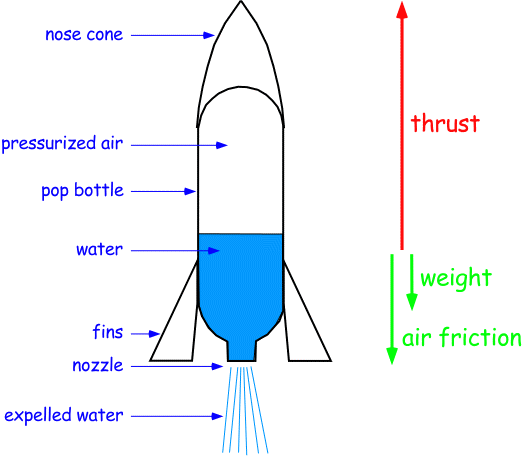|
The basic laws driving water rockets our Newtons's first and third laws. Newton's first law; states that an object at rest
tends to stay at rest unless acted apon by an external force, and an object in motion will stay in motion unless acted on
by an outside force. When a water rocket is sitting on the launch pad there is no external force acting on it. Therefore as
stated in Newton's first law it will stay at rest. Newton's third law states; for every action there is an opposit and equal
reaction. In the case of a water rocket the action is the water being shot out the back of the rocket and the reaction is
the rocket going up. The rocket would continue going up forever, if there were no external forces acting on it to slow it
down.

There are two main forces that are trying to keep the rocket on the launch pad gravity and drag. Inorder for any rocket to
even lift off the launch pad an inch, the rocket has to have more pounds of thrust than the wieght of the rocket. The strength
of a rocket engine is measured in pounds of thrust in the U.S. and newtons in Europe (4.5 newtons equals 1 pound of thrust.
For example if you have a rocket that ways 1 pound you will need at least 2 pounds of thrust to lift the rocket off the launch
pad.
How do you improve the height of the rocket?
You can improve the hieght of the rocket by increasing the pressure. Meaning increasing the rate at which the water
is shot out the back of the rocket. When you increase the pressure this also shortens your burn time. Although the burn time
will be shortened the rocket still will travel a much higher distance. You can also expeiriment using different rocket nozzles.
By varying nozzle sizes you can change the burntime , which may result in higher altitudes.
Backsliding
My favorite type of recovery system is backsliding. This means that instead of the rocket coming down straight it comes down
sideways. This is achieved by movingt the center of gravity below the center of area. You can expierement by adding wieghts
to the fins of your rocket. This moves the center of gravity back.(I use duct tape to tape quarters to the fins). If you add
to much weight the rocket will become unstable. If you don't add enough it will come down straight. Finding the perfect combination
can take several tries, so don't give up if it doesn't work the first time.
A typical water rocket launch
Step 1: Pressurizing the air tank to 100psi using an air compressure
Step 2: Loading the rocket, launcher, air tank, air hose, rope, duc tape, weight, and water into the car.
Step 3: Checking to make sure we didn't forget anything.
Step 4: Setting up the launcher (connecting the air hose from the air tank to the launcher).
Step 5: Filling the water rocket with water
Step 6: Loading the water rocket onto the launcher
Step 7: Checking the systems
Step 8: Countdown from 5 to 0.
Step 9: Launching the rocket.
Step 10: Retriving the rocket
Click here to see some launch photos
Send feedback!
|

